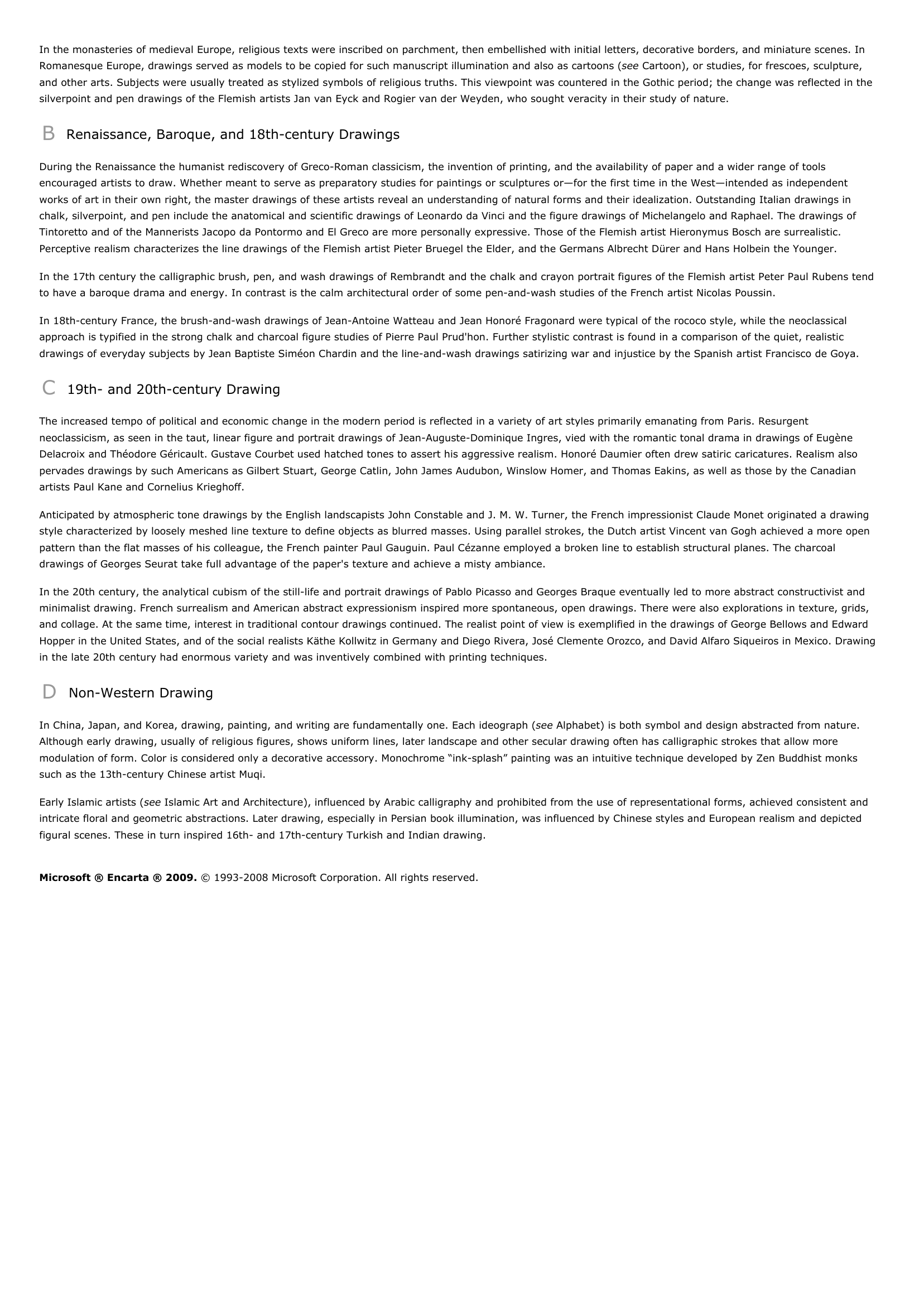Drawing I INTRODUCTION Drawing, delineation of form upon a surface, usually a plane, by means of lines and tints or shading.
Publié le 12/05/2013
Extrait du document
«
In the monasteries of medieval Europe, religious texts were inscribed on parchment, then embellished with initial letters, decorative borders, and miniature scenes.
InRomanesque Europe, drawings served as models to be copied for such manuscript illumination and also as cartoons ( see Cartoon), or studies, for frescoes, sculpture, and other arts.
Subjects were usually treated as stylized symbols of religious truths.
This viewpoint was countered in the Gothic period; the change was reflected in thesilverpoint and pen drawings of the Flemish artists Jan van Eyck and Rogier van der Weyden, who sought veracity in their study of nature.
B Renaissance, Baroque, and 18th-century Drawings
During the Renaissance the humanist rediscovery of Greco-Roman classicism, the invention of printing, and the availability of paper and a wider range of toolsencouraged artists to draw.
Whether meant to serve as preparatory studies for paintings or sculptures or—for the first time in the West—intended as independentworks of art in their own right, the master drawings of these artists reveal an understanding of natural forms and their idealization.
Outstanding Italian drawings inchalk, silverpoint, and pen include the anatomical and scientific drawings of Leonardo da Vinci and the figure drawings of Michelangelo and Raphael.
The drawings ofTintoretto and of the Mannerists Jacopo da Pontormo and El Greco are more personally expressive.
Those of the Flemish artist Hieronymus Bosch are surrealistic.Perceptive realism characterizes the line drawings of the Flemish artist Pieter Bruegel the Elder, and the Germans Albrecht Dürer and Hans Holbein the Younger.
In the 17th century the calligraphic brush, pen, and wash drawings of Rembrandt and the chalk and crayon portrait figures of the Flemish artist Peter Paul Rubens tendto have a baroque drama and energy.
In contrast is the calm architectural order of some pen-and-wash studies of the French artist Nicolas Poussin.
In 18th-century France, the brush-and-wash drawings of Jean-Antoine Watteau and Jean Honoré Fragonard were typical of the rococo style, while the neoclassicalapproach is typified in the strong chalk and charcoal figure studies of Pierre Paul Prud'hon.
Further stylistic contrast is found in a comparison of the quiet, realisticdrawings of everyday subjects by Jean Baptiste Siméon Chardin and the line-and-wash drawings satirizing war and injustice by the Spanish artist Francisco de Goya.
C 19th- and 20th-century Drawing
The increased tempo of political and economic change in the modern period is reflected in a variety of art styles primarily emanating from Paris.
Resurgentneoclassicism, as seen in the taut, linear figure and portrait drawings of Jean-Auguste-Dominique Ingres, vied with the romantic tonal drama in drawings of EugèneDelacroix and Théodore Géricault.
Gustave Courbet used hatched tones to assert his aggressive realism.
Honoré Daumier often drew satiric caricatures.
Realism alsopervades drawings by such Americans as Gilbert Stuart, George Catlin, John James Audubon, Winslow Homer, and Thomas Eakins, as well as those by the Canadianartists Paul Kane and Cornelius Krieghoff.
Anticipated by atmospheric tone drawings by the English landscapists John Constable and J.
M.
W.
Turner, the French impressionist Claude Monet originated a drawingstyle characterized by loosely meshed line texture to define objects as blurred masses.
Using parallel strokes, the Dutch artist Vincent van Gogh achieved a more openpattern than the flat masses of his colleague, the French painter Paul Gauguin.
Paul Cézanne employed a broken line to establish structural planes.
The charcoaldrawings of Georges Seurat take full advantage of the paper's texture and achieve a misty ambiance.
In the 20th century, the analytical cubism of the still-life and portrait drawings of Pablo Picasso and Georges Braque eventually led to more abstract constructivist andminimalist drawing.
French surrealism and American abstract expressionism inspired more spontaneous, open drawings.
There were also explorations in texture, grids,and collage.
At the same time, interest in traditional contour drawings continued.
The realist point of view is exemplified in the drawings of George Bellows and EdwardHopper in the United States, and of the social realists Käthe Kollwitz in Germany and Diego Rivera, José Clemente Orozco, and David Alfaro Siqueiros in Mexico.
Drawingin the late 20th century had enormous variety and was inventively combined with printing techniques.
D Non-Western Drawing
In China, Japan, and Korea, drawing, painting, and writing are fundamentally one.
Each ideograph ( see Alphabet) is both symbol and design abstracted from nature. Although early drawing, usually of religious figures, shows uniform lines, later landscape and other secular drawing often has calligraphic strokes that allow moremodulation of form.
Color is considered only a decorative accessory.
Monochrome “ink-splash” painting was an intuitive technique developed by Zen Buddhist monkssuch as the 13th-century Chinese artist Muqi.
Early Islamic artists ( see Islamic Art and Architecture), influenced by Arabic calligraphy and prohibited from the use of representational forms, achieved consistent and intricate floral and geometric abstractions.
Later drawing, especially in Persian book illumination, was influenced by Chinese styles and European realism and depictedfigural scenes.
These in turn inspired 16th- and 17th-century Turkish and Indian drawing.
Microsoft ® Encarta ® 2009. © 1993-2008 Microsoft Corporation.
All rights reserved..
»
↓↓↓ APERÇU DU DOCUMENT ↓↓↓
Liens utiles
- William Blake I INTRODUCTION William Blake (1757-1827), English poet, painter, and engraver, who created an unusual form of illustrated verse; his poetry, inspired by mystical vision, is among the most original, lyric, and prophetic in the language.
- Edgar Allan Poe I INTRODUCTION Edgar Allan Poe (1809-1849), American writer, known as a poet and critic but most famous as the first master of the short-story form (see Short Story), especially the psychological horror tale.
- Dragon Dragon, a legendary reptilian monster similar in form to a crocodile and usually represented as having wings, huge claws, and a fiery breath.
- perspective (art) perspective (art), technique permettant de représenter sur une surface plane des objets dans une position et à une distance données.
- Places and form of power

































